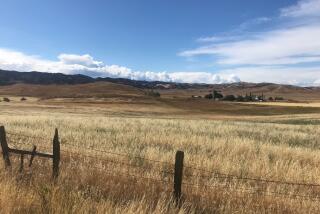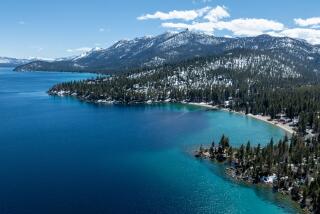Sunshine at Lake Tahoe
- Share via
A new master plan for the controlled development of the Lake Tahoe Basin has been written and ratified by the California-Nevada Tahoe Regional Planning Agency. Soon a lawsuit brought against TRPA by the California attorney general and the League to Save Lake Tahoe will be dismissed and a four-year-old building moratorium ended. A long, bitter chapter in the political history of this magnificent Sierra Nevada lake basin, a natural feature that is almost unique in the world, seems to be over at last.
The basin now has a plan that has the general support of development interests at Lake Tahoe and of environmental groups--the outcome of intense negotiations over many months. Not everyone is happy, but all had a chance to be heard.
The settlement might never have been achieved, of course, had it not been for the lawsuit and the resulting building moratorium imposed by a federal judge. This process has caused frustration and bitterness at the lake. Many people will not be able to build on lots that they bought years ago for retirement homes. Prospective business was lost because of the inability to build or expand.
But in the long run the people of the Tahoe basin and the residents of both states will benefit. Nevada, California and the federal government all have lot-purchase programs under way to compensate aggrieved landowners. And the limited new commercial development that will be allowed will be more in keeping with the protection of the mountain-lake environment that attracted people to Lake Tahoe in the first place.
The new 20-year plan sets specific annual allocations for new residential, commercial and tourist-industry growth. Generally, the residential limit would be 300 new houses a year. But the plan also contains an incentive factor to improve the Tahoe environment and to allow additional construction as well. The issuance of new building permits may be accelerated if, after an early period of highly restricted growth, there is demonstrable improvement in air and water quality.
The work is not over, of course. The next step is to raise funds for the erosion control that will be needed to halt the runoff pollution that threatens to turn lake waters of still almost magical clarity into a murky muddle. The cost is estimated to be $160 million on the California side over the next decade, and the league is seeking support in the Legislature for a $75-million bond issue in 1988. The amount may be controversial in these days of competition for bond funds, but a start must be made.
An encouraging note in recent months, according to the League to Save Lake Tahoe, has been the backing from the office of Gov. George Deukmejian for full appropriations for Lake Tahoe entities, including TRPA and bond funds for lot purchases. During a tour of the lake early in his reelection campaign, the governor pledged to work for the preservation of its natural qualities. Such support is critical to the long-range success of an effective Tahoe planning effort.
Lake Tahoe will never be entirely saved from the environmental threats of development. The TRPA planning process has been controversial, and will continue to be controversial. But it is well to speculate, on occasion, what the Tahoe basin would be like had nothing been done.
More to Read
Sign up for Essential California
The most important California stories and recommendations in your inbox every morning.
You may occasionally receive promotional content from the Los Angeles Times.













